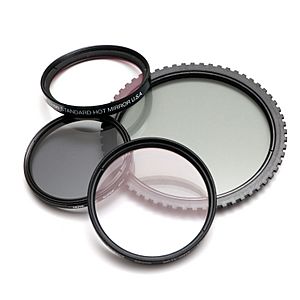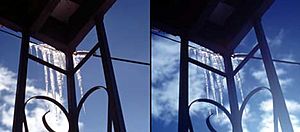Photographic filter facts for kids
A photographic filter is like a special piece of glass or plastic that you put in front of a camera lens. Its job is to change the light that enters the camera. This helps photographers take better pictures or create cool effects.
There are many different kinds of filters, each with its own purpose. They can help protect your camera, change colors, or make your photos look clearer.
Contents
Types of Camera Filters
Protecting Your Lens
- Clear filters are often called window glass filters. They are placed in front of your camera lens mainly to protect it. They act like a shield, keeping the lens safe from scratches, dust, and dirt.
Making Colors Better
- UV filters help reduce haziness in photos, especially in bright sunlight. They can also make colors look warmer in shaded areas. Some UV filters even fix a purple tint that can appear in digital photos.
- Color correction filters are used to make colors look natural. For example, you might use them to make outdoor film look right when shooting indoors. Or, they can help indoor film look good when used outside.
- Color filters (like red, orange, or green) are often used in black and white photography. They help make certain parts of the picture stand out more. For example, a red filter can make blue skies look darker and more dramatic.
Controlling Light and Glare
- Polarizing filters are very useful for reducing glare. They can make reflections disappear from windows or water. They also help make skies look deeper blue and clouds stand out more.
- Neutral Density filters (ND filters) reduce the amount of light entering the camera. They do this without changing any of the colors in your picture. This is helpful when you want to use a slower shutter speed in bright light.
- Infrared filters are special filters used with cameras that can see infrared light. This type of light is invisible to our eyes. These filters help create unique, dream-like infrared photos.
Special Effects Filters
- Close-up lenses or diopters are like magnifying glasses for your camera. They help you take pictures of very small things up close. This is a simple way to do macro photography.
- Diffusion filters make your subject look softer or a bit blurry. This effect can be nice for portraits, giving a gentle or dreamy look to a person's face.
How Filters Are Made
Filters can be simple and inexpensive, or they can be quite costly. The price often depends on the quality of the glass or plastic used. It also depends on how the filter is treated or coated. Some filters screw onto the front of your lens. Others fit into special holders that attach to the lens.
Images for kids
See also
 In Spanish: Filtro fotográfico para niños
In Spanish: Filtro fotográfico para niños

All content from Kiddle encyclopedia articles (including the article images and facts) can be freely used under Attribution-ShareAlike license, unless stated otherwise. Cite this article:
Photographic filter Facts for Kids. Kiddle Encyclopedia.






